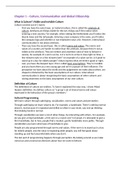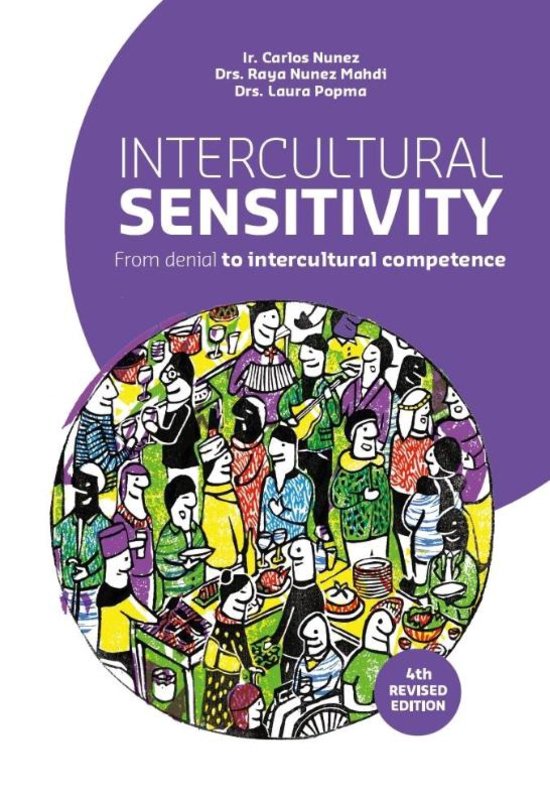Chapter 1 – Culture, Communication and Global Citizenship
What is Culture? Visible and Invisible Culture
Culture consists out of 3 layers.
- First you have the outer layer, or material culture, this is called the artefacts of
culture. Artefacts are things visible for the eye, things you’ll first notice when
entering a new country. For example, when visiting the Netherlands you’ll notice the
bicycle lanes and the tall people. Entering a new company is the same, you’ll notice
the company logo and whether or not employees wear a tie. However, intercultural
communication is not about artefacts.
- Then you have the second layer, this is called norms and values. The norms and
values of a country are harder to notice than the artefacts, because they’re not as
visible as the artefacts. They are written and unwritten rules of how to behave in
society. An example of a norm can be, is it a norm to arrive in class right on time, a
few minutes early or a few minutes later? An example of a value can be, is it good to
stand up in a bus for elderly people? Values express what we think is good or right.
- Last, you have the deepest layer, this is called basic assumptions. They’re invisible
and you learn them at a very young age and we’re unaware of their influence. The
perception we have about the world and the judgements we make about others, are
shaped or distorted by the basic assumptions of our culture. Intercultural
communication is about recognizing the basic assumptions of other cultures and
raising awareness to the basic assumptions of our own culture.
Definition of Culture
The definitions of culture are endless. To have it explained the easy way, I chose Mijnd
Huijsers definition. He defines culture as “a group’s set of shared norms and values
expressed in the behaviour of the group’s members.”
Cultural Programming
We learn culture through upbringing, socialization, norms and values and perception.
Through upbringing we learn what to do. For example, a handshake. There’s nothing normal
about it, but because it’s repeated and drilled so often in your brain, you end up thinking
that shaking hands is normal.
Through socialization we learn a lot of other things, by interacting with others. For example,
do you give a limp handshake, a firm one or a crunch one? In Europe, it’s desirable to give a
firm handshake, but in Asia, people find a modest, gentle handshake more polite. Through
socialization you learn what type of handshake to give.
People are also programmed through norms and values. If the norm is to stand up in a bus
for elderly people, and the value is respecting older people, you will feel good about
standing up and feel uncomfortable when you don’t.
The last part of programming happens through perception. By looking around us we make
conscious and unconscious decisions about how we want to behave.
,There are three levels of programming:
Individual
Cultural
Human nature
When you haven’t eaten in days, human nature makes us look for food and consume it with
our hands. Through our cultural programming we don’t eat food with our hands, instead, we
put the food on a plate and use a fork and knife to eat it with. Some culture programming’s
teach people to never eat alone, but individuals may choose to eat alone regardless of the
disapproval of the society.
Culture and Subcultures
The word collective indicates the group or subgroups we belong to. There are a lot of
subgroups or subcultures we belong to: a regional culture, middle-class culture or company
culture, each culture with their different programming.
Hereby a list of possible subcultures:
- A continent or country (Asian culture, European culture, Japanese culture, Brazilian
culture)
- Religion (Catholic, Buddhist, Islamic or Jewish culture)
- Profession (health-care, engineering or economics and management culture)
- Gender (culture of men, women, the LGBT culture)
- Ethnic (culture of ethnic minorities in the Netherlands, such as the Indonesian,
Surinam or Moroccan culture)
- Age (culture of young people, baby-boomers or the pre-war generation)
Culturally diverse teams can work out for the best but also for the worst. If a team is left
unmanaged and cultural differences are ignored, the teams can have a lot of trouble
understanding each other and coming to an agreement. If a team is managed, trained in
intercultural sensitivity and appreciates the culture differences, they can be the most
creative and dynamic teams.
Intercultural Communication
Communication is the exchange of meaning. When giving someone information, you are the
source. Information is encoded by appropriate language, gestures or non-verbal expressions.
Information is then transmitted through a channel, which is the medium of the channel.
With face-to-face verbal communication, it’s the air and distance between you, with written
communication it’s paper and with e-mails it’s electronics. The process of communication is
an on-going circular process.
Communication always takes place within a context. This can be a family context, business
context, crisis context or intercultural context.
Intercultural communication is the communication between sources and receivers from
different cultures. It requires an interculturally sensitive attitude, cultural knowledge and
skills in frame-of-reference-shifting, in short, it requires intercultural competence. A well
coded message in one culture, can have a total different meaning in another culture, when
decoded in another culture. Or when transmitted through a different channel, for example,
by e-mail or face-to-face. People are often unaware of this, because these cultural
differences are the basic assumptions of a culture.
, Noise. What exactly is Communication Noise?
Noise is anything that distorts or blocks the message and distracts the receivers or causes
them not to understand the message. You have external, internal and cultural noise.
External noise, also known as physical noise, is interference from the environment. External
noise makes it difficult to understand someone. This can be, because someone is talking very
loud which leads to you not hearing the person.
Internal noise, or physiological noise, involves emotions, worries or personal prejudices.
When you’re angry, sad, worried or maybe even in love, it’s hard to pay attention to what is
being said. A personal prejudice can also stand in the way of understanding someone. A
biased observer watching an excellent presentation given by a student who wears a
headscarf, might not hear or appreciate the presentation because of his or her personal
prejudice.
Cultural noise occurs when there are differences in cultural programming. For example,
proper volume for speaking professionally in Indonesia can be lower than in the
Netherlands. Or the right amount of eye contact in one culture, can be too much for another
culture.
TOPOI Model, Intervention for Cultural Noise
TOPOI stands for: Tongue, Order, Person, Organization and Intention & Influence. It shows
five areas of possible miscommunication.
In order to find the miscommunication, you need to use the 5 letters as a checklist to reflect
on the miscommunication. Then you need to ask the three key intervention questions and
any other question that may be necessary for feedback or clarity.
3 Key Intervention Questions:
1. What is my share in the misunderstanding?
2. What is the other person’s share?
3. What is the influence of the social environment – the norms, values and general
beliefs?
T is for Tongue or Language. The language aspect of communication, verbal and non-verbal.
Verbal language has meanings which you can look up in the dictionary. Still, one word can
have a total different meaning in another country. For example, in the Netherlands we say
‘half three’, this means half past two, not half past three. When showing up late, reflect on
the T for verbal language and ask the 3 key questions.
Non-verbal language is something you can’t look up in the dictionary, it can differ in meaning
and interpretation. For example, in a lot of countries things can be given and received with
both left and right hand, but not in Indonesia. In Indonesia you give and receive everything
with your right hand, except if it’s injured. Your left hand is used for the restroom. When
something like this happens, ask for feedback and give feedback.
O. The first O in TOPOI stands for Order. The importance of the O is realizing that there’s
never one truth or reality. It’s about each participant’s view. How do they view, order and
organize reality? Everyone sees the world through different glasses and has their own view
on reality and their own logic. Behaviour is guided by our own sense of logic.






